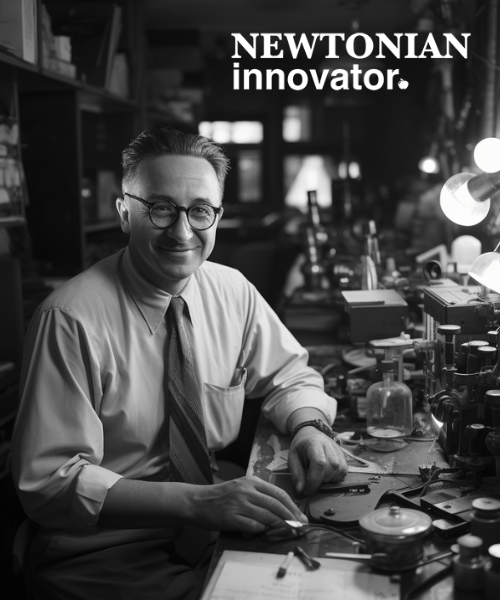In the 1860s, physicist James Clerk Maxwell conceived a thought experiment involving a hypothetical intelligent being, now known as Maxwell’s demon. It could sort hot and cold molecules in a chamber, apparently violating the second law of thermodynamics.
Maxwell was a Scottish physicist and mathematician, widely regarded as one of the most influential scientists in history. Born in Edinburgh in 1831, Maxwell displayed prodigious intellectual abilities from a young age. He attended the University of Edinburgh and later Cambridge University, where he became a fellow at Trinity College.

Maxwell’s most notable achievement is the formulation of Maxwell’s equations, a set of differential equations that describe how electric and magnetic fields interact. These equations, which unified electricity and magnetism into a single theory of electromagnetism, laid the foundation for much of modern physics, including the theory of relativity. Beyond electromagnetism, Maxwell also made significant contributions to the field of thermodynamics, introducing the concept of the Maxwell distribution in the kinetic theory of gasses. This is where Maxwell’s Demon came into play. Maxwell imagined a tiny creature (the “demon”) that could control a small door between two chambers of gas. By selectively allowing faster-moving molecules to pass in one direction and slower-moving molecules in the other, the demon could effectively cause one chamber to heat up and the other to cool down, seemingly decreasing the total entropy of the system without any work being done.
While Maxwell’s Demon was a purely theoretical thought experiment, it sparked significant debate and discussion among physicists. Over time, it was realized that the act of the demon measuring the speed of molecules and deciding which ones to let through would itself require energy, thus preserving the integrity of the Second Law. The thought experiment has since served as a foundational exploration of the relationship between information, energy, and entropy in thermodynamics.
The legacy of Maxwell’s Demon extends far beyond the confines of thermodynamics, illustrating the timelessness of great scientific ideas. This thought experiment, which once probed the intricacies of entropy and energy, became a testament to the power of interdisciplinary thinking. Nearly a century after Maxwell’s original proposition, physicist Leo Szilard, inspired by the demon’s conceptual framework, ventured into the realm of genetics.
In the 1960s, Szilard adapted the Maxwell’s Demon thought experiment to the world of genetics, imagining an intelligent being with the capability to sort chromosomes and genes. This leap from physics to biology underscores the interconnectedness of scientific disciplines and the boundless potential of foundational ideas. It serves as a poignant reminder that the musings of one scientist can echo through time, inspiring and challenging future generations to view problems through a different lens, even in seemingly unrelated fields.
Leo Szilard was a Hungarian-American physicist who helped develop the atomic bomb through the Manhattan Project. Born in Budapest in 1898, Szilard studied engineering before turning to physics research in Berlin during the 1920s. Fleeing Nazi Germany in 1933, he moved briefly to England before immigrating to the United States. Szilard was instrumental in convincing Albert Einstein to send his famed 1939 letter to President Roosevelt warning of German nuclear capabilities. This helped spur the creation of the Manhattan Project.
In his personal life, Szilard was never married and had no children. He lived frugally, often in hotel rooms, owning little more than necessary clothing and usually donating his speaking fees to charity. Szilard was an outspoken opponent of nuclear weapons despite his role in their creation. Though he hoped that nuclear weapons could somehow be abolished globally, Szilard shifted his focus to developing peaceful applications of nuclear energy. He also continued exploring new concepts in physics including information theory and bioinformatics. Szilard worked tirelessly on physics research until his death from bladder cancer in 1964 at the age of 66. Although he had few close personal relationships, Szilard left an immense scientific legacy and remains an influential figure in the history of nuclear physics.
Leo Szilard’s adaptation of Maxwell’s demon to genetics helped establish Szilard as an innovator connecting concepts across disciplines. Having already done groundbreaking work in nuclear physics through the Manhattan Project, Szilard was now demonstrating his creative thinking in genetics and information theory. The thought experiment showcased Szilard’s ability to take ideas from thermodynamics and apply them in another scientific field.
In the 1960s, physicist Leo Szilard proposed adapting this thought experiment to genetics. Instead of sorting molecules, Szilard imagined the demon sorting chromosomes and genes. The demon would have knowledge of which chromosomes and alleles were “desired” and “undesired.” It could then separate them, isolating the desired ones on one side of a cell and undesired ones on the other.

On a chromosomal level, the genetic demon might isolate sex chromosomes, sorting X’s and Y’s. Or it could separate chromosomes carrying genetic diseases from healthy chromosomes. At the genetic level, the demon could isolate beneficial genes from harmful mutations. Similar to Maxwell’s original demon decreasing entropy in a gas chamber, the genetic demon could decrease genetic entropy by intelligently sorting biological components.
The hypothetical genetic demon highlighted how the principles of entropy and information theory apply to genetics as much as thermodynamics. While imaginary, Szilard’s proposal helped establish genetics as an information science, paving the way for modern day applications of information theory in DNA analysis and bioinformatics. Just as the original demon leveraged knowledge of molecular speeds, the genetic demon would need advanced knowledge of each gene and chromosome’s properties. And in both cases, the act of acquiring and applying this knowledge allowed the decrease of entropy against natural processes. His innovative thinking exemplified the immense value of curiosity-driven research in expanding scientific frontiers.
Publications on Maxwell’s demon in genetics helped cement Szilard’s reputation as an innovative leader capable of advancing entire fields of science through his creative thinking. By proposing bold thought experiments, Szilard demonstrated the rare insight that made him so influential throughout his career, both within physics and beyond. Today, the field leverages information theory extensively, from entropy applied to population genetics to information encoded in DNA and cellular processes.
Future scientists should feel motivated to explore ideas simply for greater understanding, not just defined objectives. Szilard’s career demonstrates the importance of following intellectual curiosity wherever it leads. The thought experiment with the genetic demon was not aimed at any practical goal, yet it advanced genetics by prompting unconventional thinking.
Throughout history, the evolution of science has been excelled by brilliant minds that dared to question, imagine, and dream. The thought experiments of the past, like Maxwell’s Demon, are not just relics of a bygone era. but inspirations that can illuminate the path for future explorations. They serve as a testament to the enduring nature of curiosity and the boundless expanse of human imagination.
In today’s rapidly expanding scientific landscape, it is tempting to focus solely on the cutting-edge, often overlooking the foundational ideas that paved the way. Yet, it is in these foundational concepts that we often find the seeds of tomorrow’s breakthroughs. By revisiting and reimagining the thought experiments of yesteryear, we can discover different perspectives and innovative solutions to contemporary challenges.
To the scientists of today and tomorrow, let the past guide you and embrace the wisdom of those who came before. The true essence of science lies not just in understanding the world as it is, but in envisioning what it could be. Harness your creativity, let your imagination soar, and dare to think outside the confines of the conventional box.
In the end, the future of science is not just about new technologies or groundbreaking discoveries; it’s about the audacity to dream, the courage to question, and the passion to explore the infinite archives of knowledge, wherever it may lead.






